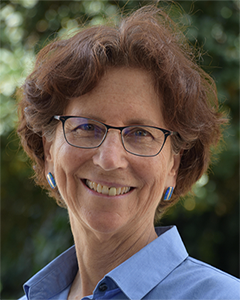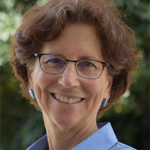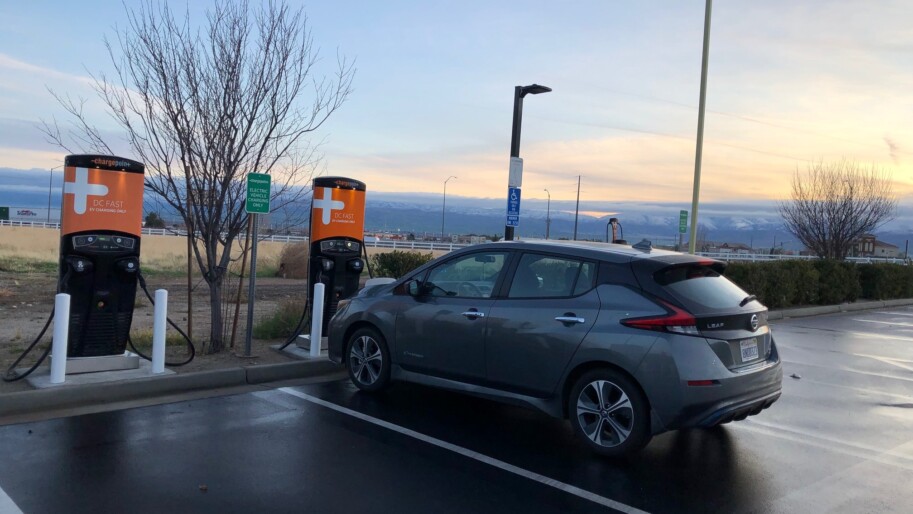By Ellie Cohen
As the great-horned owl hooted in the pre-dawn darkness, we packed up our fully charged 2019 Nissan Leaf SV Plus (180 freeway miles per charge) and began our journey south (395 miles south!). Feeling like pioneers of the past, Ann, Amanda and I were prepared.
The week before we’d downloaded the latest PlugShare app. Amanda mapped out where all the CHAdeMO fast chargers* were and calculated how far we could get on each leg to avoid range anxiety but still make it in a reasonable amount of time. We figured that a “normal” drive down to Los Angeles from the North Bay takes about six hours so driving an electric vehicle (EV) would take about nine.
We avoided the morning rush hour traffic by leaving early and reached I-5 as the sun was rising. It was a beautiful, cold January morning and we were hopeful. Before we knew it, we were at our first charging stop, in Santa Nella (124 miles from our start with 33% left on the battery). Using our PlugShare app, we confirmed that the charger had been used recently so, we assumed, it would be working today.

Alas, we pulled up to the Best Western Anderson (next door to the famous purveyor of pea soup and other fine highway foods), and found an ancient looking, and sadly, broken EVgo charger (photo- still believing it was functional!). After spending about 45 minutes trying to make it work (which included making several phone calls to the 800 number on the charger that only yielded endless busy signals, and after engaging with the hotel staff hoping they could make it work but to no avail), we decided to try another charger.
Guided by PlugShare, we simply crossed the freeway and as if entering a futuristic Emerald City, found a row of modern chargers at a Valero gas station (yes, the despised company from Texas that invested millions in California to undo our climate protection laws). There was a single Chargepoint CHAdeMo fast charger that we could use. Across the vast asphalt parking lot, were another 12 gleaming Tesla chargers, whose connectors were cleverly designed for just that, Teslas alone. If only….
Nonetheless, Ann whipped out her Chargepoint card, miraculously set up some time ago with her credit card as this was not something we had planned for. We giddily swiped the card, plugged in the charger, and the blue dashboard indicator lights lit up. It worked (photo- happy and self-assured)! We took a walk, grabbed some coffee, and had a delicious burrito breakfast at a taco truck when Ann was notified on her phone that the charge was complete. One hour and we were fully charged!
We were feeling very confident as we embarked on our next leg. Per our carefully laid out plan, we knew we’d have to charge once more before heading up the Grapevine then down into San Fernando Valley. Our destination was Studio City where we would be staying for five days in Los Angeles, visiting climate and community leaders for insights about our Climate-Safe California campaign for rapid decarbonization.
 We were satiated and happy, planning out our upcoming meetings, sharing personal stories, counting an unbelievable 23 total Amazon Prime trucks that day (photo: doctored truck message**), and enjoying each other’s company.
We were satiated and happy, planning out our upcoming meetings, sharing personal stories, counting an unbelievable 23 total Amazon Prime trucks that day (photo: doctored truck message**), and enjoying each other’s company.
We were not paying attention to our speed.
Now, if you’ve ever driven down I-5, you’d know that the speed limit is 70 but most travel at an average of over 80 miles per hour. The thing about electric cars is that once you start traveling over a certain speed, the remaining battery power can drop quickly and precipitously. At some point during our exuberant conversation, we glanced at our dashboard to check how much battery power we had left.
The mood turned serious. We were down to 36 miles with 34 miles to go. Uh oh…
The next closest CHAdeMO fast charger was 14 miles away but it was an EVGo at a hotel, with no recent users per PlugShare. It did not bode well based on our earlier experience. Sure enough, the outdated-looking charger was not functional. We called the 800 number again but to no avail.
Now we had to decide what to do. We could try for the next CHAdeMO charger but we’d have to drive under 55 miles per hour to hopefully make it or, we could use a trickle charge, regular outlet at the hotel. We decided we should try to add 5% to the battery and then we’d venture south. The front desk attendant was kind enough but at the deserted hotel, seemed a bit concerned about allowing us to plug in inside. We were fortunate to find an outdoor 3-pronged outlet. We plugged in. An hour later, we had only 1% more! We waited another 45 minutes, the percentage reading was the same but we decided to head south.
The next 60 minutes of driving were filled with range angst underlying quiet conversation. Miraculously, around five miles before Route 43 towards Taft (southwest of Bakersfield) where PlugShare indicated the next CHAdeMO charger was located, our remaining mileage started to go up in the car. Another fascinating aspect of EVs is that when you travel downhill or brake, the engine can regenerate energy into the battery! Phew…
There we found, across the lot from even more Tesla charging stations, eight Electrify America chargers (infrastructure owned by Volkswagon and apparently constructed as part of their Dieselgate settlement). Seven of the eight chargers were CCS, usable by many brands of EVs, but not the Nissan Leaf.
One charger was all we needed and there was one CHAdeMO. The sun was starting to set. It was hard to read the screen. Another uh oh…the screen was only showing computer code. It was getting cold. We called the 800 number. Miraculously, a lovely, live human being answered. We provided the serial number of that particular charger and after two lengthy reboots, the screen was up and the charger was humming. We were ecstatic!
Tired and relieved, we sat indoors at an adjacent food mart, charging our cell phones, snacking and listening to country music piped in from the local radio station. Suddenly, breaking through the din of the soft drink refrigerators, we heard someone speaking about climate change. It was a “Tom Steyer for President” ad. No escaping the campaign even here in the southern reaches of the Tulare Basin!
Since the battery was quite low at this point (~ 7% charge remaining), it took another 1.5 hours even with the fast charger to become almost full. The last hundred miles were thankfully uneventful as we cautiously climbed the Grapevine, drove over Tejon Pass (4,160’ elevation) and cruised down into Los Angeles County, completing our more than 12 hour journey with a delicious hot meal in Studio City.
 Our days in LA were filled meeting with a dozen inspiring and accomplished civic leaders (photo- after visiting partners at the LA Cleantech Incubator).
Our days in LA were filled meeting with a dozen inspiring and accomplished civic leaders (photo- after visiting partners at the LA Cleantech Incubator).
On the last night, we planned our drive home.
In just over nine hours, we were back in the North Bay, this time having counted many fewer Amazon Prime trucks, but an impressive 24 Red-tailed Hawks along I-5 (maybe due to the winter storm that had blown through the night before). We had already begun planning our next trip—likely driving a Tesla or maybe even a Bolt instead—and planning out part of our campaign, to expand clean energy EV infrastructure for all!
*There are 3 major types of EV fast chargers: Tesla, CCS and CHAdeMO. CCS is the most common in Europe for a wide range of makes. CHAdeMO is most common in Japan. Read more here.
**Consumption-based emissions, the full life-cycle emissions embedded in goods, foods, travel and services from out-of-boundary locations- are most often not counted in greenhouse gas emissions inventories. In Marin County alone, these are estimated to account for 3x more emissions than tracked emissions. Learn more here and here.


